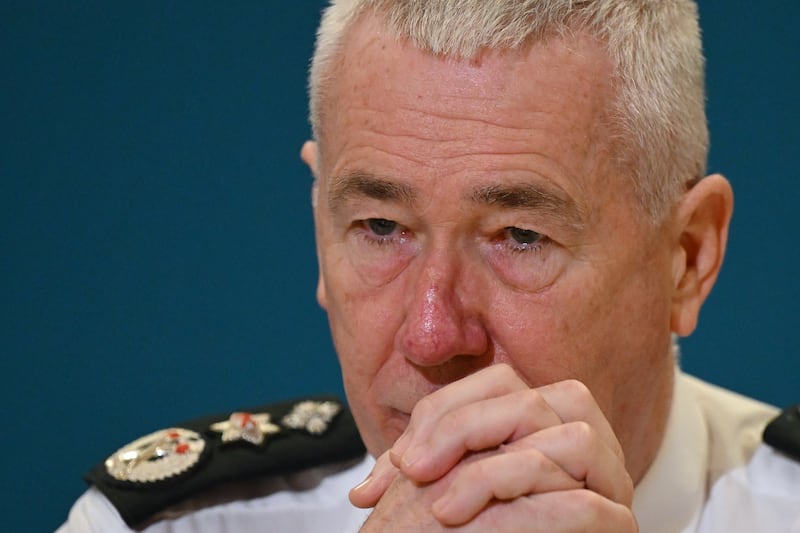Jane O’Leary has a very attractive habit of gesticulating with her fingers. It might be tapping them out to explain something, such as how she goes about composing music, or about first moving to Ireland, in 1972. As she teases out or muses or recalls, her slim pianist’s fingers play it out in the air or on the table.
There’s a musicality in her voice, too, as she moves from muttering to animated, as the story requires, and hunches forward or leans back, as if playing her life with disarming delicacy.
We’re at the table in the front window of her home in Galway. She and her husband, Pat O’Leary, a retired maths lecturer at the city’s university, are just back from Italy, which she has adored since she had a fellowship in Siena when she was 21, “absorbing this European culture”. There are pistachio and almond dolci that they brought back on the table, and a plate of locally bought cannoli.
Also on the table are some notes she’s made for me of her many highlights and joys, a CD and the programme for the debut performance by Concorde, Ireland’s first new-music ensemble, which she founded in 1976, and for which she has composed, played piano and toured internationally.
RM Block
Yet, she says, “I hate looking back. I like to look forward. This is kind of traumatic for me. I have to remember, what did I do?”
We’re here because O’Leary, a founding member of Aosdána and Music for Galway, is preparing to receive the National Concert Hall’s lifetime-achievement award, at a performance this autumn of her Triptych by the National Symphony Orchestra and ConTempo Quartet, conducted by Kensho Watanabe.
O’Leary has been a pioneering advocate for contemporary music in Ireland for more than 50 years, as a composer, promoter and educator.
When people ask her, “I never say I’m a composer. Until my 70s I didn’t like to say. It’s part of what I do. I’m a musician. I make music and I listen to it; I think about it. I work with others in the field. I’m part of a community. That’s what matters to me.”
All the same, as a composer, “90 per cent of it is totally on your own, in your head. Time disappears.”

O’Leary defines contemporary music as “of the moment”, by living composers. “Within that there could be almost anything.” It comes out of a classical tradition, she says, but it’s trying to create a new language. Her advice for listeners is to “be open-minded: don’t bring any preconceived expectations. Just go with the flow and let the music lead you. It will be unknown and completely different.”
She talks about how a piece of new music is momentary, “brushing past you” in an instant. “You’re just going to have an impression.” For her that’s “the difficulty and the magic”. So it’s important to programme good pieces – those that “deserve another hearing” – again and again, for listeners to get more out of them.
In Concorde’s early days there was only the initial live performance, so repeating was crucial. “I’m proud we gave a lot of Irish composers their first performance. To see them keep going means a lot.”
O’Leary has been composing for 57 years. Early on, “if you got one performance a year you were happy. Now it’s getting three, four and, whew, can’t keep up with it. There is a much nicer feeling about music being written today. It’s healthier, definitely.”
Jane Strong was born in October 1946, growing up in Wethersfield, a suburb of Hartford, Connecticut. Her father was an architect, her mother a painter who had to give up teaching art on marriage. She shows me a painting of a lobster boat. “She was an amazing artist,” O’Leary says of her mother, who would point out colour and detail, and whose visual sense has permeated O’Leary’s music.
“I think my music is quite visual, whether it’s movement or shape. I think of music as sculptural. When I’m creating I’m shaping sounds, imagining something that isn’t there yet.”
Although Jane Strong loved drawing, “the piano was like my best friend”, and it was her choice at Vassar, the liberal-arts college in New York state. “I am so glad I didn’t go to a conservatory. I wanted a broad exposure. I studied history of art; English was my minor. There were wonderful music teachers.” Until she went to Princeton, in New Jersey, for a PhD, “I had no idea about composing.”
She loved visiting her maternal grandmother, Mary Teresa McCormack, the daughter of an Irish immigrant, on the Atlantic coast in Scituate, south of Boston. “The waves were huge. I was mad about it, this magical, big house.” The sea is significant in her work, and she lives close to it still. Her father’s lineage goes back to the Mayflower, so “one of the great experiences of my life” was writing Some Call It Home for the Mayflower 400 celebrations; it was performed in June 2021 at Theatre Royal Plymouth, in the English city from which the ship sailed for the New World in 1620.
At Princeton she met a young Pat O’Leary from Waterford, fresh from what was then University College Galway on a Fulbright scholarship. “And that changed my life.” Did falling for an Irishman throw her off track? “I didn’t have a track. That’s the thing. I had no idea what I would do.”
They both arrived in Princeton in the autumn of 1968 for PhDs, she in composition, he in applied maths. “The graduate school was very small. Everybody had breakfast together.” Maths and music often align. “His brain is different from mine, but we think similarly, I suppose, about things.”
They married in 1971 and came to Ireland in 1972, when she was 26. “I’m not one for waiting around. Mother wasn’t thrilled with me going off a long way. I had to go up to the Ardilaun [Hotel] to make phone calls. We couldn’t get phones here until the pope came.”
They were in Galway for two years, then in Dublin for three. O’Leary taught at DIT College of Music, on Chatham Row. She met other musicians and composers, joined a young composers’ association. “There wasn’t much happening in the contemporary field,” she says. So she and some colleagues founded the Concorde ensemble in 1976. “Who’d have thought we’d still be going in the 21st century?”
Their first two concerts were free events at the US embassy and the Royal College of Surgeons in Ireland, featuring a line-up of American music. “We gave a horrendously difficult concert programme. Everybody spent six months preparing for it, and we had no fees. There was no money. The Arts Council said, ‘What’s that? Contemporary music? Never heard of that.’ I said, ‘Look, we’ll do it anyway. We’ll show you what it is.’”
Afterwards Concorde did get funding. “The second year was very tough. We went to Kilkenny and had two people in the audience.”
All changed with three concerts at the Hugh Lane Gallery, in Dublin, in 1978. “That was fantastic. It worked. The audience were curious, interested. That became our home. I just loved it because it seemed right with the art.”
With Concorde she has commissioned more than 200 pieces from established and emerging international and Irish composers. The Hugh Lane has commissioned her to write a piece marking 50 years of its concerts, for Concorde to perform in September. Her inspiration is The Eve of St Agnes, the gallery’s stained-glass window by Harry Clarke.

Back in the early days she did it all: musician, composer, music promoter, organiser. “Writing press releases, doing finances, everything. The things 10 people do now. I did everything myself, but I didn’t do it on my own. That’s important.” Others were always involved, but it wouldn’t have happened without her. “I admit I was the driving force, and I did a lot of the work. All the work!” She laughs heartily.
When Pat got a physics lectureship at University College Galway they moved back to the city with their toddler, Owen, who was born in 1977. Caitriona followed in 1983. “I had a young child, a new house. That’s all exciting, so you don’t worry too much about the other stuff. But I couldn’t work or anything. There weren’t any jobs.”
The university “was very small. Everybody knew everybody. They were very welcoming and friendly and supportive.” She started teaching music-appreciation night classes there. “They came in droves. They loved it. Everybody was eager.”
She recently found her notes, and cassette tapes she made, with examples broken down, which she played during lectures. She did classes all over the west. (“I spent my life on the train.”) Out of that her mission became creating a community linking performers, listeners and composers, bringing wonderful music to Galway regularly, making it accessible.
The venues were horrible, O’Leary says. She recalls a pedal falling off a piano during a performance. “Somebody in the audience went up to fix it. My friend Erica Casey and I looked at each other: we have to do something.” They launched Galway Steinway Trust, raising money in six months to buy a grand piano. They persuaded the university to install it on the new floor of the Aula Maxima.
“We needed to run some concerts, and Music for Galway evolved from that,” in 1981. “There was immediate interest. They had all contributed money for the piano, and they felt part of it. From the beginning they were very eager in Galway. The core group was university staff.”
But concerts were not enough. They wanted musicians living in Galway, too, and in 2003 she and Sally Coyle, chair of Music for Galway, spearheaded the Galway Music Residency, with ConTempo Quartet the resident ensemble since then. “They’re amazing, and it’s been wonderful to have continuing relationships, to hear them again and again in different contexts. I’ve really enjoyed writing for them.”
The residency is still going strong, rebranding shortly as MusicConnects. “It’s something I’m proud to have been involved in.” In October ConTempo plays her Taking Flight, inspired by murmurations of birds, in Headford, and at St Nicholas’s in the city.
She led Music for Galway for 32 years, until 2013, when, she says, smiling, “I managed to escape, and I set up a position for an artistic director so somebody would get paid for it.”
Then “2012 was my annus horribilis”. Their daughter Caitriona, aged 28 and living in England, died after an incident in Eastbourne, on the south coast, in the summer of that year. She was “very independent and wild in a way, and creative”, and obsessed with horses. “The two kids were completely different. Owen followed Pat’s path. He works for Apple in San Francisco. Caitriona did her own thing”, travelling, studying philosophy. “She was killed by a horse,” in a riding accident.
“I was very ill almost the whole year with cancer, and she died in the middle of that,” says O’Leary, who was recovering from major surgery and in the middle of chemotherapy. “I was completely out of it, not functioning fully. I was not able to go. Pat had to manage all that.”
Catriona had just been home to see her mother. “She was in a good place, which makes me happy. We had a lovely visit. She went back on Sunday night, and on the Monday night the police came to the door ... Such shock. You don’t really register it for a long time. But, look, you just keep going. I was so ill I couldn’t get up for months.”
Death “puts things in perspective. I don’t think long term. Keep going, one foot in front of the other. Move through time, one day at a time, and then it kind of becomes part of you, and you live with it; you accept it, I suppose. It’s always there.
“And there’s a spiritual connection with people who aren’t here. I feel the loss, obviously, and yet I’m glad that I had her, and she was there. Sometimes I wonder what would she think of the world today. She’d be 41.”
A few days later O’Leary sends lovely notes and links, including one to a video she created (with her friend Marie Hanlon, the artist), of A Way Through, composed for Concorde after Caitriona’s death. “I think the visual adds a lot to the music. That was expressing my feelings. It ends on a hopeful note.”
She has just recorded a piece with a trio from the Hard Rain Soloist Ensemble, in Belfast, for the Songs about Buildings and Moods series of videos directed by her friend Seth Boustead, the American composer. Her inspiration for it was the Wonderful Barn, a famine-relief project in Co Kildare that is now one of Ireland’s finest follies. In addition, another piece of O’Leary’s, Dancing with Shadows, get its Irish premiere in September.
She tries to explain how she composes. “I decide the instruments. Then I sit at the piano” – as she does now, to demonstrate – “and pick out some sounds and pitches and play notes. I get a line or a chord or shape of sounds. I fool around with it, start writing it down roughly. Notation is so difficult.”
She sighs. “I struggle with historic notation to represent the sounds I’m trying to convey, which are much more than just pitch and rhythm. I often have to use words to describe the sound. I scribble on the page, and I come back the next day and say, no, that’s rubbish!
“I might take a little bit of it and start again, and I tweak and tweak and tweak. At some point it begins to have a life of its own.”
She selects bits she’ll use with a green highlighter and red pen, then transfers them to her computer. “It begins to take shape. Then you refine it again. Eventually you’ve got a lovely printed copy.”
At Princeton O’Leary studied under Milton Babbitt, the renowned composer and music theorist. “He was very exact in choosing pitches and rhythms.” She learned the 12-tone system, and talks about using all 12 before repeating them, making patterns, transposing them, “doing them backwards and upside down, manipulating pitch patterns.
“It was very important to learn, but the system itself was a bit rigid. I see it as a way of breaking up the eighth-century harmonic system I learned in [Vassar], the classical tradition, Haydn, Mozart.”
Then she wrote pieces. “I learned a lot about manipulating pitches and patterns. That was important. It didn’t really work for me, but I don’t regret any of it. I think it took me 15 years afterwards to actually loosen up and let go of the systems and just trust myself.”
By that stage she was living in Galway. “I remember saying to myself in 1983, I think I’m just going to forget everything and start with no ideas.”
Being a founding member of Aosdána, the academy of creative artists, from 1981 was a privilege, and “recognition of composition as a valid activity”, she says. “I needed that validation from Aosdána to keep going. It wasn’t about the money. It was hugely important for my self-confidence in the composition part of my life, and it also allowed me to be free with my time to promote the general idea of music and as well as writing it.”
She wrote Triptych between 2017 and 2019 for the National Symphony Orchestra and ConTempo, “out of love, to enjoy the colours and sounds of an orchestral palette with the layering of a string quartet, which acts as a unit, not as four individuals. That’s the appeal of it for me.”
It was performed in February 2020, just before lockdown, at the New Music Dublin festival, but not with ConTempo, so the NCH performance will be special “to me and to them”.
Everything other than composition has been communal. Composition is just her. “I still find it strange to be in the spotlight.”
The National Concert Hall will mark Jane O’Leary’s lifetime-achievement award, with a concert featuring Triptych and other works, on Friday, October 24th; Dancing with Shadows is at the Model, in Sligo, on Sunday, September 7th; Concorde will perform The Eve of St Agnes at the Hugh Lane Gallery, in Dublin, on Sunday, September 14th



















